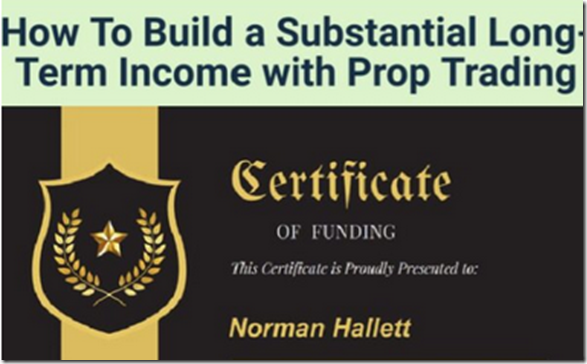Overview of the Course: How To Build a Substantial Long-Term Income with Prop Trading
The course, How To Build a Substantial Long-Term Income with Prop Trading by Norman Hallett, is designed for traders interested in understanding and succeeding in the world of proprietary (prop) trading. It focuses on the following key areas:
- Understanding Prop Trading Mechanics: Gain insights into how proprietary firms operate and generate profits.
- Limited Financial Risk: Explore how prop trading offers access to firm capital, minimizing personal financial exposure.
- Opportunities for Disciplined Traders: Recognize the potential for long-term profitability by adhering to the principles of disciplined trading.
The Advantages of Prop Trading
Prop trading offers several distinct advantages that can significantly enhance a trader’s profitability:
- Access to Capital: Traders can leverage firm capital to trade without risking their own funds.
- Reduced Personal Financial Risk: Since traders are not using their own money, the financial burden is mitigated.
- Structured Environment: Proprietary firms often provide training, support, and a structured trading environment that can help traders succeed.
- Profit Sharing: Traders can earn a share of the profits they generate, creating a strong incentive to perform well.
The Importance of Using the Right Trigger to Pass the Evaluation with Ease
Passing the evaluation phase is a critical step in prop trading. This course section emphasizes:
- Optimal Win Ratio: Learn the win ratio needed to succeed in evaluations.
- Maintaining Discipline: Address the common challenge of maintaining trading discipline throughout the evaluation process.
- Avoiding Pitfalls: Equip yourself with strategies to sidestep the typical mistakes that often hinder new traders.
These insights ensure that you can meet the expectations of prop firms while enhancing your trading skills.
How to Manage Drawdown Rules and Trade with Confidence
Managing drawdown is a fundamental aspect of succeeding in prop trading evaluations. In this segment, you will learn:
- Efficient Loss Management: Techniques for keeping drawdowns low, which is essential for passing evaluations.
- Trading with Confidence: By mastering drawdown control, you can trade with a relaxed mindset, which positively impacts performance.
- Accelerated Evaluation Process: Understanding drawdown management can significantly shorten the time required to pass the firm’s evaluation.
This knowledge empowers you to trade effectively while minimizing the risks associated with high drawdowns.
Running Your Prop Trading Like a Business
For sustained success in prop trading, it’s vital to treat your trading activities as a business. This section covers:
- Creating a Sustainable Trading Model: Develop a model that works for long-term income generation, whether for retirement or portfolio diversification.
- Testing Funding Amounts: Learn how to evaluate different funding levels to find what works best for you.
- Account Management: Understand when to reset your account and how to size your positions correctly to ensure a steady income stream.
By adopting a business mindset, you can build a more reliable and consistent trading career.
How to Get Funded in 10 Days
This final section provides a step-by-step blueprint to securing funding quickly, including:
- Real-Life Examples: Discover how the course creator secured a $50,000 account in just 10 days and a $150,000 account in 22 days.
- Actionable Steps: Detailed strategies that you can implement immediately to enhance your chances of becoming a funded trader.
With this comprehensive blueprint, you will be equipped with the tools and knowledge needed to achieve funding success rapidly.
In summary, Norman Hallett’s course on prop trading provides a thorough education on navigating the complexities of proprietary trading, emphasizing discipline, risk management, and the importance of treating trading as a business. Whether you’re a seasoned trader or a newcomer, this course offers valuable insights that can lead to substantial long-term income.
Download Proof (2.89 GB)



